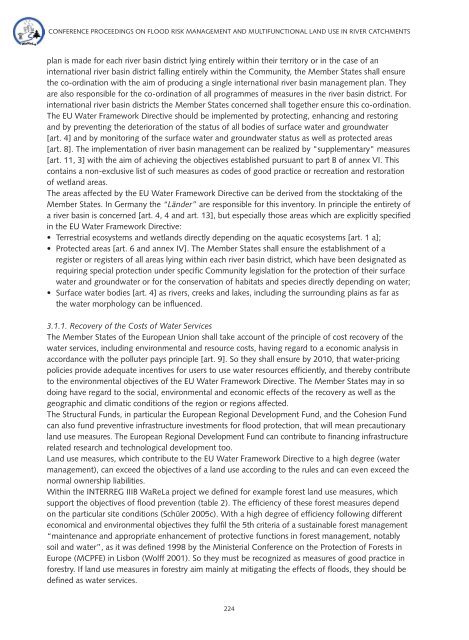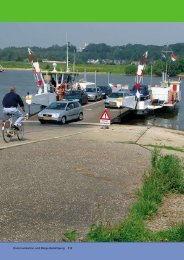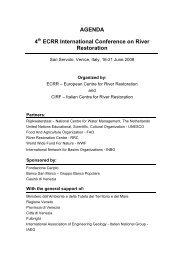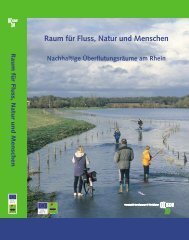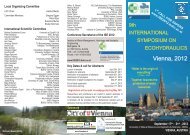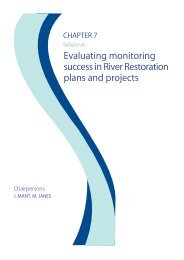multifunctional land use - European Centre for River Restoration
multifunctional land use - European Centre for River Restoration
multifunctional land use - European Centre for River Restoration
You also want an ePaper? Increase the reach of your titles
YUMPU automatically turns print PDFs into web optimized ePapers that Google loves.
CONFERENCE PROCEEDINGS ON FLOOD RISK MANAGEMENT AND MULTIFUNCTIONAL LAND USE IN RIVER CATCHMENTS<br />
plan is made <strong>for</strong> each river basin district lying entirely within their territory or in the case of an<br />
international river basin district falling entirely within the Community, the Member States shall ensure<br />
the co-ordination with the aim of producing a single international river basin management plan. They<br />
are also responsible <strong>for</strong> the co-ordination of all programmes of measures in the river basin district. For<br />
international river basin districts the Member States concerned shall together ensure this co-ordination.<br />
The EU Water Framework Directive should be implemented by protecting, enhancing and restoring<br />
and by preventing the deterioration of the status of all bodies of surface water and groundwater<br />
[art. 4] and by monitoring of the surface water and groundwater status as well as protected areas<br />
[art. 8]. The implementation of river basin management can be realized by "supplementary" measures<br />
[art. 11, 3] with the aim of achieving the objectives established pursuant to part B of annex VI. This<br />
contains a non-exclusive list of such measures as codes of good practice or recreation and restoration<br />
of wet<strong>land</strong> areas.<br />
The areas affected by the EU Water Framework Directive can be derived from the stocktaking of the<br />
Member States. In Germany the “Länder” are responsible <strong>for</strong> this inventory. In principle the entirety of<br />
a river basin is concerned [art. 4, 4 and art. 13], but especially those areas which are explicitly specified<br />
in the EU Water Framework Directive:<br />
• Terrestrial ecosystems and wet<strong>land</strong>s directly depending on the aquatic ecosystems [art. 1 a];<br />
• Protected areas [art. 6 and annex IV]. The Member States shall ensure the establishment of a<br />
register or registers of all areas lying within each river basin district, which have been designated as<br />
requiring special protection under specific Community legislation <strong>for</strong> the protection of their surface<br />
water and groundwater or <strong>for</strong> the conservation of habitats and species directly depending on water;<br />
• Surface water bodies [art. 4] as rivers, creeks and lakes, including the surrounding plains as far as<br />
the water morphology can be influenced.<br />
3.1.1. Recovery of the Costs of Water Services<br />
The Member States of the <strong>European</strong> Union shall take account of the principle of cost recovery of the<br />
water services, including environmental and resource costs, having regard to a economic analysis in<br />
accordance with the polluter pays principle [art. 9]. So they shall ensure by 2010, that water-pricing<br />
policies provide adequate incentives <strong>for</strong> <strong>use</strong>rs to <strong>use</strong> water resources efficiently, and thereby contribute<br />
to the environmental objectives of the EU Water Framework Directive. The Member States may in so<br />
doing have regard to the social, environmental and economic effects of the recovery as well as the<br />
geographic and climatic conditions of the region or regions affected.<br />
The Structural Funds, in particular the <strong>European</strong> Regional Development Fund, and the Cohesion Fund<br />
can also fund preventive infrastructure investments <strong>for</strong> flood protection, that will mean precautionary<br />
<strong>land</strong> <strong>use</strong> measures. The <strong>European</strong> Regional Development Fund can contribute to financing infrastructure<br />
related research and technological development too.<br />
Land <strong>use</strong> measures, which contribute to the EU Water Framework Directive to a high degree (water<br />
management), can exceed the objectives of a <strong>land</strong> <strong>use</strong> according to the rules and can even exceed the<br />
normal ownership liabilities.<br />
Within the INTERREG IIIB WaReLa project we defined <strong>for</strong> example <strong>for</strong>est <strong>land</strong> <strong>use</strong> measures, which<br />
support the objectives of flood prevention (table 2). The efficiency of these <strong>for</strong>est measures depend<br />
on the particular site conditions (Schüler 2005c). With a high degree of efficiency following different<br />
economical and environmental objectives they fulfil the 5th criteria of a sustainable <strong>for</strong>est management<br />
“maintenance and appropriate enhancement of protective functions in <strong>for</strong>est management, notably<br />
soil and water”, as it was defined 1998 by the Ministerial Conference on the Protection of Forests in<br />
Europe (MCPFE) in Lisbon (Wolff 2001). So they must be recognized as measures of good practice in<br />
<strong>for</strong>estry. If <strong>land</strong> <strong>use</strong> measures in <strong>for</strong>estry aim mainly at mitigating the effects of floods, they should be<br />
defined as water services.<br />
224


